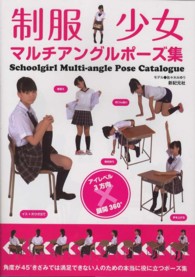Full Description
Confronting gaps in school achievement requires a systematic examination of the entire school system and a comprehensive problem-solving approach. Written for school leaders, this completely revised and expanded edition outlines 50 detailed, researched-based strategies for developing high-performing schools.
Emphasizing the provision of equal educational opportunities for all learners, this book is organized around six critical standards:
- Teach a well-crafted, focused, valid, and clear curriculum
- Align assessments, programmes, and instructional resources with curriculum
- Promote student equality and equity
- Focus on mastery learning and effective teaching strategies
- Provide resources for establishing curriculum expectations, monitoring, and accountability
- Institute effective district and school planning, staff development, and resource allocation to create a quality learning environment
With field-tested best practices and an expanded bibliography and research base, this hands-on guide provides school leaders with strategies that give all learners the opportunity to succeed.
Contents
Preface
Dedication
About the Author of the Facilitator's Guide and Video
About the Authors of the Book
How to Use This Guide
Standard by-Standard Study Guide for 50 Ways to Close the Achievement Gap by Carolyn J. Downey, et al.
Welcome and Book Study Seminars Introduction
Introduction Mini-Lecture I.1: Beginnings and Study Seminar Goals
Video Segment and Discussion Activity I.2: Author Goals and Introduction
Reading and Discussion Activity I.3: Book Preface and Introduction
Reading and Discussion Activity I.4 Six Standards
Video Segment and Discussion Activity I.5: History and Overview
Journal Exercise Handouts for Welcome and Book Study Seminars Introduction
Standard One: Establish a Well-Crafted, Focused, Valid, and Clear Curriculum to Direct Teaching
Introduction Mini-Lecture and Discussion Starter Activities 1.A: Standard One Introduction
Video Segment and Discussion Activity 1.B: Standard One Overview
Reading and Journal Exercise Activity 1.C: Nine Strategies of Standard One
Discussion Activity 1.D: Analysis of Standard One
Video Segment and Discussion Activity 1.E: User Comments Regarding Standard One and Its' Strategies
Application Exercise 1.F: Recommended Next Steps for Moving Toward the Meeting of Standard One Expectations
Closure Activities 1.G: Plus/Delta and Reflection
Journal Exercise Handouts for Standard One
Standard Two: Provide Assessments with the Curriculum
Introduction Mini-Lecture and Discussion Starter Activities 2.A: Standard Two Introduction
Video Segment and Discussion Activity 2.B: Standard Two Overview
Reading and Journal Exercise Activity 2.C: Nine Strategies of Standard Two
Discussion Activity 2.D: Analysis of Standard Two
Video Segment and Discussion Activity 2.E: User Comments Regarding Standard Two and Its' Strategies
Application Exercise 2.F: Recommended Next Steps for Moving Toward the Meeting of Standard Two Expectations
Closure Activities 2.G: Plus/Delta and Reflection
Journal Exercise Handouts for Standard Two
Standard Three: Align Program and Instructional Resources with the Curriculum
Introduction Mini-Lecture and Discussion Starter Activities 3.A: Standard Three Introduction
Video Segment and Discussion Activity 3.B: Standard Three Overview
Reading and Journal Exercise Activity 3.C: Nine Strategies of Standard Three
Discussion Activity 3.D: Analysis of Standard Three
Video Segment and Discussion Activity 3.E: User Comments Regarding Standard Three and Its' Strategies
Application Exercise 3.F: Recommended Next Steps for Moving Toward the Meeting of Standard Three Expectations
Closure Activities 3.G: Plus/Delta and Reflection
Journal Exercise Handouts for Standard Three
Standard Four: Use a Mastery Learning Approach and Effective Teaching Strategies
Introduction Mini-Lecture and Discussion Starter Activities 4.A: Standard Four Introduction
Video Segment and Discussion Activity 4.B: Standard Four Overview
Reading and Journal Exercise Activity 4.C: Seven Strategies of Standard Four
Discussion Activity 4.D: Analysis of Standard Four
Video Segment and Discussion Activity 4.E: User Comments Regarding Standard Four and Its' Strategies
Application Exercise 4.F: Recommended Next Steps for Moving Toward the Meeting of Standard Four Expectations
Closure Activities 4.G: Plus/Delta and Reflection
Journal Exercise Handouts for Standard Four
Standard Five: Establish Curriculum Expectations, Monitoring, and Accountability
Introduction Mini-Lecture and Discussion Starter Activities 5.A: Standard Five Introduction
Video Segment and Discussion Activity 5.B: Standard Five Overview
Reading and Journal Exercise Activity 5.C: Five Strategies of Standard Five
Discussion Activity 5.D: Analysis of Standard Five
Video Segment and Discussion Activity 5.E: User Comments Regarding Standard Five and Its' Strategies
Application Exercise 5.F: Recommended Next Steps for Moving Toward the Meeting of Standard Five Expectations
Closure Activities 5.G: Plus/Delta and Reflection
Journal Exercise Handouts for Standard Five
Standard Six: Institute Effective District and School Planning, Staff Development, and Resource Allocation, and Provide a Quality Learning Environment
Introduction Mini-Lecture and Discussion Starter Activities 6.A: Standard Six Introduction
Video Segment and Discussion Activity 6.B: Standard Six Overview
Reading and Journal Exercise Activity 6.C: Eleven Strategies of Standard Six
Discussion Activity 6.D: Analysis of Standard Six
Video Segment and Discussion Activity 6.E: User Comments Regarding Standard Six and Its' Strategies
Application Exercise 6.F: Recommended Next Steps for Moving Toward the Meeting of Standard Six Expectations
Closure Activities 6.G: Plus/Delta and Reflection
Journal Exercise Handouts for Standard Six
Summary and Multi-Year Planning
Reading and Discussion Activity S.A: Summary
Video Segment and Discussion Activity S.B: Themes
Video Segment and Discussion Activity S.C: Planning
Video Segment and Discussion Activity S.D: Conclusion
Ways to Organize the Book Study
Seminar Series Evaluation Sample
References








